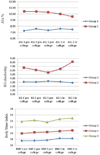Changes in type 1 diabetes health indicators from high school to college
- PMID: 26199180
- PMCID: PMC4723297
- DOI: 10.1080/07448481.2015.1068780
Changes in type 1 diabetes health indicators from high school to college
Abstract
Objective: Evaluate trajectories of type 1 diabetes health indicators from high school through the first year of college.
Participants: Seventy-four students with type 1 diabetes who maintained pediatric endocrinology care during the first year of college.
Methods: Hemoglobin A1c (HbA1c), blood glucose monitoring frequency, body mass index (BMI), and clinic attendance data were collected via retrospective medical chart review in spring 2012. Group-based trajectory models evaluated diabetes-related health indicators over time and identified distinct growth trajectory groups.
Results: BMI increased and clinic attendance decreased in the first year of college. Trajectories for other health indicators were heterogeneous and stable over time; 69% of students were classified as having stable good glycemic control. Racial minority youth and youth on conventional insulin regimens were disproportionally represented in higher-risk groups.
Conclusions: Diabetes health indicators are stable or decline upon college entrance. Results signal the need for targeted support for college students with type 1 diabetes.
Keywords: Adherence; clinical medicine; diabetes; young adults.
Figures
References
-
- Roth C. Supporting young adults with diabetes: changing systems to address the issues. American Association for Diabetes Educators 2014 Annual Meeting & Exhibition; August, 2014; Orlando, FL.
Publication types
MeSH terms
Substances
Grants and funding
LinkOut - more resources
Full Text Sources
Other Literature Sources
Medical

